- Regular Price
- £19.99
- Sale Price
- £19.99
- Regular Price
- £19.99
- Unit Price
- per
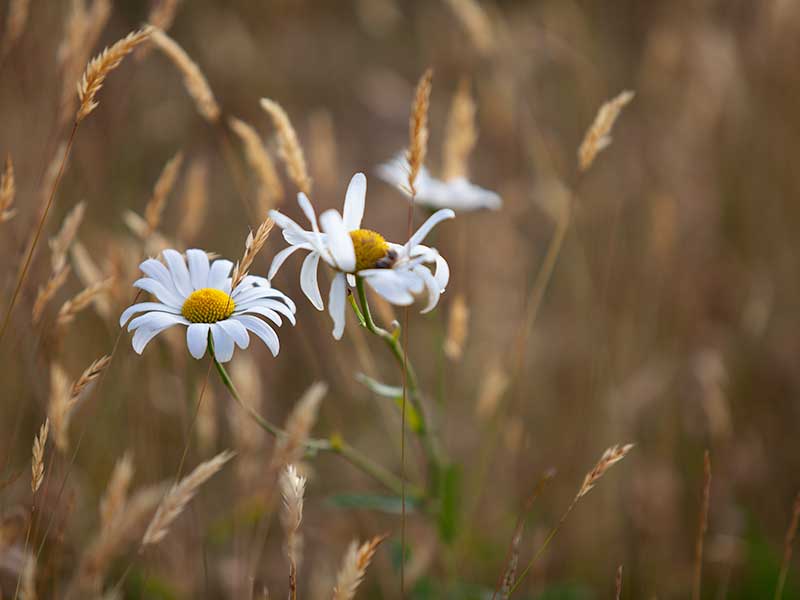
Several years ago, Harry and I embarked on a mission to transform our small field used for grazing sheep, which was devoid of diverse plant species and wildlife into a thriving wildflower meadow.
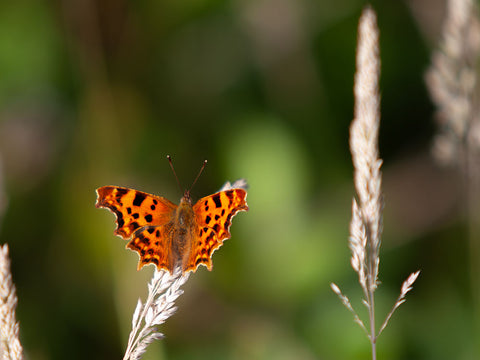
Comma Butterfly
The field is bounded on two sides by ancient woodland and a stream, making it an essential sanctuary for bats, nesting birds, insects and larger mammals.
Our Inspiration: Philip Hambly and Butterfly Conservation
Philip Hambly, our mentor and loveliest wise man on all things wild, has advised us that having very old woodland and water next to a meadow is ideal as it helps provide a complete ecosystem. Philip is the Chairman of the Cornwall branch of Butterfly Conservation. Together with his wife Faith, he has transformed their 52-acre farm Lethytep into an extraordinary wildlife haven over the past 25 years. Just last week, they hosted 500 visitors from the Cornwall Wildlife Trust, demonstrating what's possible with dedication and passion. Dare to watch his fascinating film here - the beauty of what they have created is infectiously captivating. Be warned, you might catch the 'bug' and feel compelled to return every inch of your ground to nature. https://www.youtube.com/watch?v=Z1Bpk4rAsYg
Our field pricks nostalgic memories of my childhood, so happy to be alone, just sitting, watching and immersed in nature.
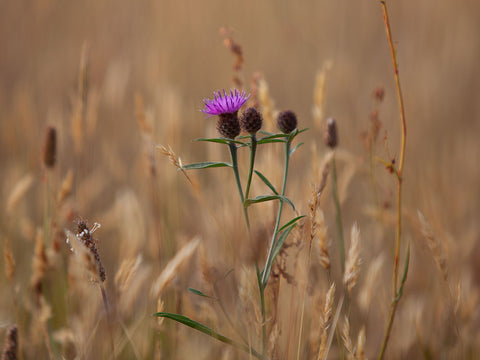
Knapweed
Philip cautioned that such a transformation wouldn't happen overnight. So, armed with his wisdom, we first sowed bucket loads of Yellow Rattle seeds we scythed from one of his meadows, scattering them across an area at the winward corner of the field and then sacks of native wildflowers suitable for our soil and found seeds for the margins that were close to the woods, and specific seeds for the small area at the bottom of our east facing slopey field that stays moist all year covered in rushes. We have many moles and their molehills, so with a metal rake, took the top of the molehills off and sprinkled seeds into this fresh friable soil and then raked the soil back over them. Philip's dismissive observation: "That's not going to work. They're not carrots! Nature will do it in her own time. "

Yellow Rattle Seed Heads Wrapped in a Web
When Spring arrived, I eagerly started walking the field, anxiously scanning for the first signs of Yellow Rattle and anything else that didn't look like grass or docks. Finally, I spotted small, unfamiliar plants scattered in the areas where we had sown the seeds. These very quickly became a sea of yellow.
And how did my sacks of carefully 'planted' wildflower seeds do? Was the field full of waving flowers throughout the summer? No. Just a few poppies, although spectacular in themselves, didn't quite match the botanical tapestry I expected from the vast amount of seeds put down. Philip might be right....
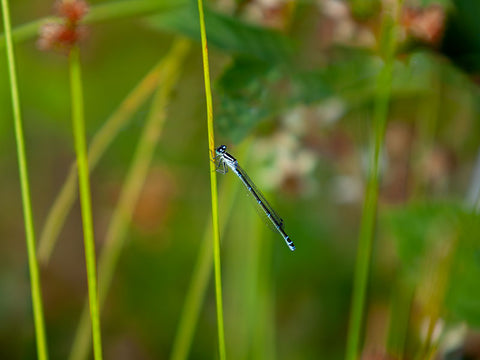
Damselfly
Over the next couple of years, however, our meadow did develop, with more and more orchids (Marsh and Greater Butterfly) every year popping up. Some of those original seeds did germinate and these have re-seeded and increased in number every year. I might mention this to Philip...
However, last year the dominance of Yellow Rattle took centre stage, and possibly because the summer was dry, all the different array of grasses were very meagre and short. Our local farming contractor was derisive after he appraised the field for hay: "Waste of time and money!" It wasn't cut, so we brought the sheep back in to do it for us.
So how has this summer faired so far, marked by relentless drought? I walk around the little path that traces the edges of the field at least once a day studying changes from the previous year.
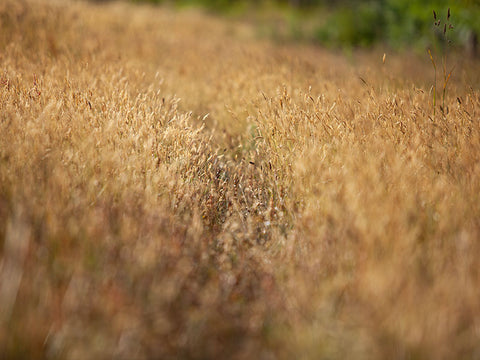
Our path around the field in the evening light
The Yellow Rattle was slow to awaken, and when it did, was shorter and seemed intent on getting to seed as quickly as possible. The small pockets of Birds Foot Trefoil we had last year, had now spread right across the field along with Bugle, Sorrel, Speedwell, buttercups (two types), Hawksbeard, Knapweed, Cuckoo Flowers, and Lesser Trefoil, Starwort and all colours of clover. The many different varieties of grasses surprisingly have been far more widespread and seem to have enjoyed this Spring. When the wind blows, it's reminiscent of the sea in waves of yellows. The orchids seem to have suffered somewhat with less quantities for both varieties this year. They are shorter and didn't last quite as long as normal. We were excited to have found little pockets of an extremely pretty, delicate pink flower which we had never seen before, but looking them up on our fabulous little app (PictureThis) discovered they were Ragged Robbin, a relative of the Red Campion. We were disappointed that many disappeared overnight, no doubt from the deer who use the field as their dining room in the evenings. But 5 plants managed to go to seed.

Delicate Ragged Robin Flower
The field was humming and fluttering like mad.

Dragonfly
Clouds of Meadow Brown butterflies rise as you walk, along with Large Skipper Butterflies, Six-spot Burnet Moths, dragonflies, damselflies, bees, grasshoppers, flies and wasps galore.
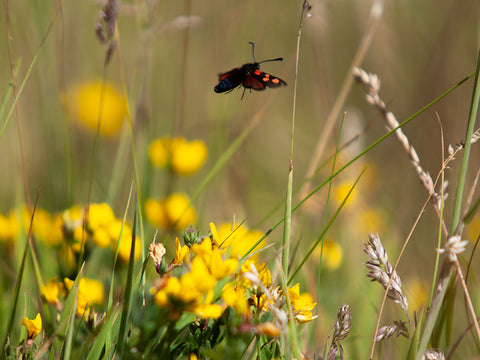
Six Spot Burnet Moth Flying after a meal on the Birds Foot Trefoil
The tawny owls seem to have done well this year, as we have familiar hooting from many of the trees at dusk, from all directions, but all very close together. There is a healthy contingent of Chiff Chaffs and Blue Tits that whizz out from the woods to catch the abundance of flying creatures. But apart from a few gorgeous Comma butterflies and Common Blue, it seems a bit strange there are no others. Until, I watched a solitary Comma Butterfly, seeking a quiet moment on a leaf, was chased away by a mob of Meadow Browns, their territorial dedication highlighting the dynamics of nature's hierarchy.
It then made sense why the other butterflies were not welcome.
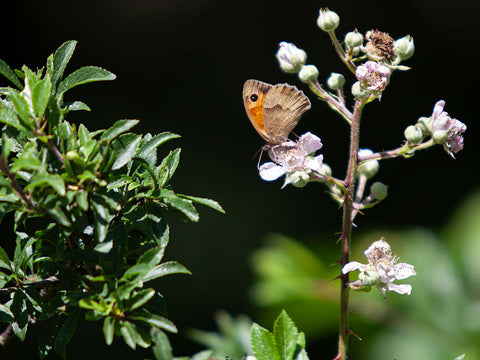
Meadow Brown Butterfly
It is amazing that over these past 5 years, the field has changed so much, and every year there is a surprise, but the drought this year has certainly meant that the vegetation is smaller, flowering quicker and going to seed more quickly. The large downpours a week ago had an immediate impact on the Birds Foot Trefoil that overnight flowered in abundance.
The May blossom was quiet extraordinary this year, its profusion apparently due to near-perfect conditions last year for the bud formation, with warmth and heat of last summer conditions with a cold February (officially called the chill factor) to release them to flower once the season warms up.
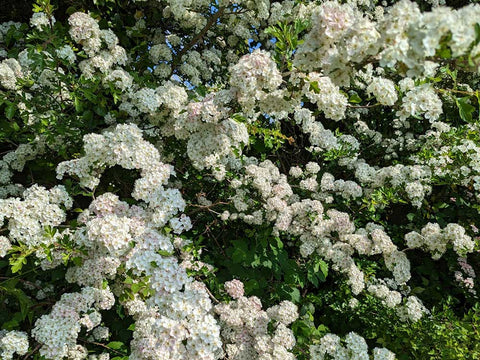
Heavenly Hawthorn: Magnificent May
My small patch of earth that I try to seed every year by our house, was a disaster last year, having carefully dug it, seeded it, watered it, I then went away for a week, leaving the watering of newly emerging seedlings was left to our daughter, who was left with strict instructions on watering every evening. These instructions were studiously ignored and everything died. I admitted defeat.
This year, as we were away in Spring, I didn't get around to dealing with it until extremely late May, but I went through all my old packets of seeds, mixed them all up, scattered them, raked them in, watered them, and they are all growing beautifully, albeit, somewhat late in the season. Here they are. Never too late perhaps...

Small patch of newly seeded wildflowers

Not quite sure what they all are!
Our previous article about the beginning of creating a wildflower meadow and how you can try out turning your own outside area into a wildlife haven can be read here: Wildflower Meadows, Large and Small.
Sarah Mayman
June 2023
2 comments
So lovely to get the updates on your meadow. You really bring it alive!
This is so lovely! Might I post this to my garden club’s Facebook? We are all trying to “go native!”